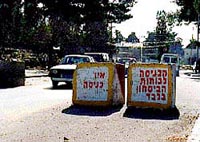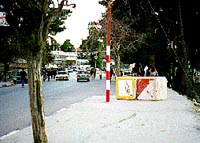
In the months prior to redeployment from Ramallah, some of the powerful symbols of occupation in the city were the painted concrete blocks that formed a ring around the city (pictured left) that told commuting Israeli settlers not to drive into the centre, and the blocked streets that controlled Palestinian entry and exit to the center of town.
The Hebrew on the painted block on the left reads En knissa ("No entry") and the block on the right warns Haknissa lekochot habitachon belivad ("Entry to security forces only").
Many people had believed these blocks represented a political declaration of the boundaries of the coming post-Oslo 2 Ramallah/Al-Bireh area but in fact the boundaries were larger, taking in much of the suburbs.
The concern behind this was proved correct in the western part of the city where "public security patrols" regularly pass, ostensibly to prevent attacks on Israeli cars on one of the several bypass roads.

By March 1996, they still remained by the side of the road to which they were moved, a memorial to the years of controlled movement inside the town. Since redeployment, freedom of movement continues to be limited outside the Palestinian Controlled Area "A" of Ramallah/Al-Bireh, cut off completely for a day in the wake of attacks inside Israel on 12th February.
On 5th March 1996, another, longer punitive closure was imposed, again in the wake of several attacks inside Israel. Closure Diary tracked these and other closures and their effect on the population.